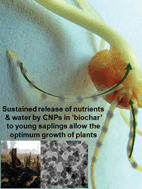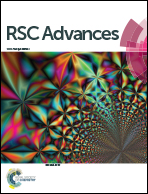Carbon nanoparticles in ‘biochar’ boost wheat (Triticum aestivum) plant growth
Abstract
Biochar is shown to contain raw carbon nanoparticles (rCNPs). The traditional use of biochar for the healthy growth of plants is due to its retention capability of nutrients for needs-based slow release. On aging, the rCNPs are aerially oxidized with the incorporation of hydrophilic carboxylic and hydroxyl groups on the biochar surface to increase its spongy structure that enhances its absorptivity to water and several ionic nutrients. The chemical oxidation of rCNPs in biochar introduces similar carboxylic acid and hydroxyl groups in transforming rCNPs to water soluble carbon nanoparticles (wsCNPs). These wsCNPs in solution enhance the growth rate of wheat plants. The concentration of wsCNPs used in this wheat plant growth study varied in the range from 10 to 150 mg L−1. The seeds treated with wsCNPs in this range showed higher growth rates, with the optimum growth found to occur with 50 mg L−1 wsCNPs, as compared with the control study. This suggests a concentration threshold of wsCNPs for the optimum stimulation of plant growth that the aged biochar can readily meet. Model experiments with ammonium nitrate as cationic and anionic nutrients show that both the rCNPs and wsCNPs hold the nutrient ions, although the negatively charged wsCNPs hold less effectively than the anionic nitrate. These carbon nanoparticles are capable of releasing cationic and anionic nutrients slowly over time. Such action is correlated with the booster action of CNPs in supplying nutrients to the young plants. Thus, wsCNPs may be a better choice than fertiliser or manure alone, due to the controlled and slow release of nutrients for better assimilation by plants.


 Please wait while we load your content...
Please wait while we load your content...